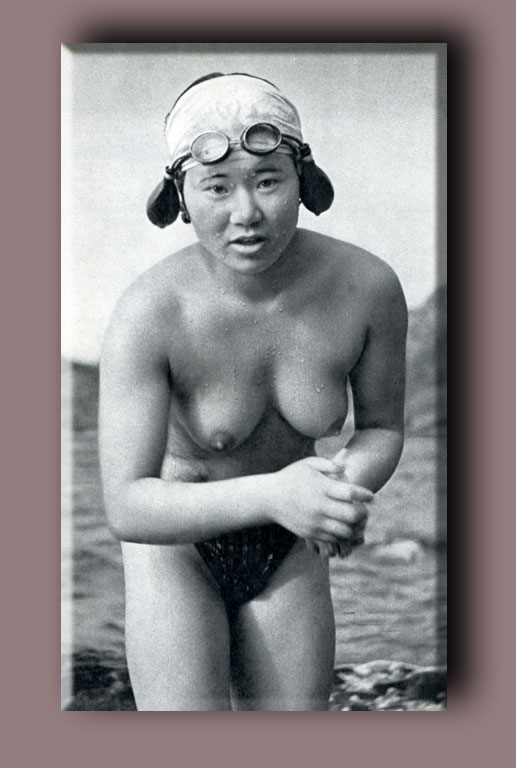Note: this was marked NSFW because of some fairly gross-looking pictures of injured eyes, and because of some pictures of traditional Japanese women divers (keep you American readers from getting into trouble at work from pictures of breasts)
Hi all, I noticed in the thread in Tail Swimming on swimming with goggles http://mernetwork.com/index/showthre...kes-rivers-sea people were talking about how deep you can go wearing goggles, and masks, without equalizing.
Thought I would see if I can post some helpful information. People call it eye squeeze (that's what my NAUI Scuba instructor used to call it) mask squeeze or goggle squeeze.
What happens with goggles?
- When you start down pressure on the outside of the goggles rises, but pressure stays the same inside. This crushes the foam seals and starts to push the hard plastic into your eye sockets, and if you go down too far you can bruise the skin around your eyes.
- The water pressure transmits to your body and your blood pressure rises, but the pressure inside the goggles stays low, so there is a tendency for the blood vessels in the whites of your eyes to bulge, and if you go down too far, they can leak blood into the white part of your eyes, making you look like a vampire.
Here are some photos of people who went down too far wearing goggles and got red eyes and bruising around the eye sockets

From my own experience, from everybody I've talked to who's tried it, and everything I've read, you should not dive deeper than 2 m/7 ft wearing the hard plastic racing goggles.
To test it I went out in the pool on one of the freediving nights with my depth gauge wearing Speedo racing goggles and slowly started down. Sure enough, by 6 or 7 feet, my eyes were feeling like they were being pushed out and going further down to 10 feet (3 metres) made me start to feel like my eyes might get hurt.
So, if you want to go deep, what's a solution to the problem?
One solution is to wear a dive mask with a nose pocket, so you can blow air into the mask through your nose and keep the pressure inside the mask equal to the water pressure outside. The problem is dive masks look even dorkier on a mermaid than goggles do, but to protect yourself if you're diving deep, or are in water you wouldn't want to get into either your eyes or your nose, it can be worth it.
Even if you do wear a mask, you must remember to equalize! From time to time people forget, and they get the red eyes. You can usually tell whether a person gave themselves a squeeze in a dive mask because they don't have the bruises around their eye sockets, they just get red eyes. Here's an example of eye squeeze from forgetting to equalize a dive mask.
So, are there goggles that let you go deep without hurting your eyes?
Yes, there are.
The problems of using goggles were known among the Ama divers of Japan & Korea, and pearl divers even in the 19th century, and most of them dived without eye protection. In the 1920s a Japanese inventor created the "self-equalizing goggles" that had a rubber bulb attached to each eyepiece by a tube, and as the diver descended, the bulb would squeeze and equalize the pressure inside the eyepiece with the outside water pressure.
They're not made anymore, but Fosco Maraini, an ethnologist from Italy, studied the Ama divers in the 1950s, because their way of life was changing fast and he wanted to capture their old way of life on film before it disappeared. Here is a photo of the goggles Ama divers used from the 1920s to the early 1960s.
Here are some photos taken in 1956 showing how the divers would wear them.

The bulbs had long tubes that went into the side of the eyepieces, and they were attached by strings or wires to the straps back around the ears, because they floated, and if they were too close to the eyepieces, they would pull the eyepiece upward.
Fosco Maraini said in his study of the Ama people, that the divers would often go down as deep as 18 m/60 ft wearing these goggles.
You can also see the weight belts these divers wore, made from 2 pieces of rope with cylindrical weights slid onto the rope, and tied in front in a knot.
BTW these women were tough, they dived in the Sea of Japan, which is a cold body of water even in summer, wearing just a bathing suit bottom. By the mid-1960s, wetsuits had come to Japan, and the Ama divers started wearing wetsuits and dive masks with nose coverage, and the old self-equalizing goggles disappeared.
It seems that it wouldn't be too hard to make goggles like this yourself. Drill holes in the eyepieces and glue in some tubes, then attach rubber bulbs at the other end and use twistems to attach them to the straps.
It would be a matter of opinion whether these goggles would look better or worse than a dive mask, though, I guess.
I think I'll continue in a separate post.



 Reply With Quote
Reply With Quote





 ).
).


 )
)








Bookmarks